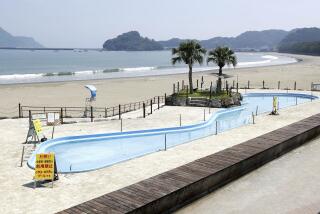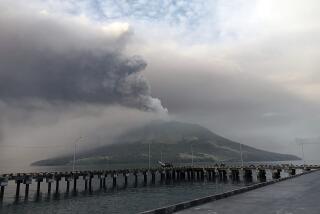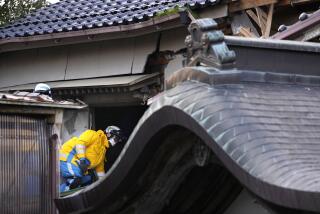Volcano Towns’ Future Shrouded in Uncertainty
- Share via
DATE, Japan — As Mt. Usu continues to huff and puff and the ground around it reshapes itself like so much Play-doh, thousands of evacuated residents face the specter of being unable to return to their homes and jobs for weeks, even months, as they wait for the mighty volcano to calm down.
It all adds up to a one-two punch for Japan’s northern island of Hokkaido. Already the most economically ravaged island in Japan’s archipelago, it supports little industry beyond agriculture and tourism, which were already reeling from the nation’s decade-long economic slump.
Ironically, the same volcanic force that now imperils the area stokes its economy in ordinary times, heating the hot springs that draw millions of tourists each year to resorts scattered around the mountain’s base.
Those resorts have been transformed into blackened ghost towns, their workers evacuated--and laid off. Even a museum about volcanoes in the town of Abuta is shuttered.
Local officials are taking no chances. “Right now, I can’t see the time when we will give permission to go home,” said a senior city official in Date.
Scientists fear that the volcano, which erupted last Friday and Saturday and has since rained several inches of soot and stones over evacuated areas, could blow more seriously in the next two weeks. Telltale signs, such as the formation of moonlike craters and buckles in the earth up to 10 feet high, suggest that a lava dome may be forming underground.
The scientists say they can’t predict whether the energy will escape quietly or rupture in a huge explosion that, in a worst-case scenario, could send lava and superheated gases down the mountainside at the speed of a bullet train, incinerating everything in its path.
“It’s OK. People are evacuated,” said Hokkaido University volcanologist Hiromu Okada. “But if they return [and it blows], they will die instantly.”
Nevertheless, restlessness is growing among the nearly 5,000 residents who have spent a week camped in makeshift shelters at schools, gymnasiums and community centers. The remainder of the 16,200 people evacuated from the three affected towns presumably are staying with relatives or friends, officials said.
Area officials were reasonably well prepared. Companies have donated water, food and blankets. Police officers are visiting the shelters to provide counseling. The shelters have televisions, and some have exercise treadmills. Local volunteer veterinarians have even set up a pet-care center, where evacuees have dropped off dogs, cats, birds, even a tortoise.
But the disruptions have been vast. Schools, which were due to start the new school year right about now, have delayed entrance ceremonies: Some of the schools are in towns that have been evacuated, while others are serving as shelters. Several roads into the affected areas have been blocked off. And many jobs have been eliminated.
It didn’t take long for the resorts to lay off their workers. Ken Inomato, 53, who managed a shop in Abuta--and now occupies a tatami mat in a shelter--got the word in a sort of whisper-down-the-cell-phone relay.
One employee passed word along to the next that everyone had been laid off because all reservations for their hotel, located on a lake in the shadow of a beautiful mountain that resembles Mt. Fuji, had been canceled.
Inomato seemed more resigned than angry. “Because of the volcano, the hot springs were created, so we had big benefits from the volcano,” he said matter-of-factly. Added Yuiko Shimizu, 68: “Everyone lived on the volcanic hot springs, so no one hates the volcano.”
Still, the toll from the mountain’s wrath is steep. Each day the resorts are deserted, the towns lose tourism revenues estimated at up to $1 million, according to the Hokkaido Commerce Assn.
Newspaper headlines also talked about devastation to farmers: Fields are still snow-dusted, but abandoned greenhouses hold scallions, spinach, broccoli and onions. “Tomatoes from Date in Crisis,” blared one newspaper headline.
Not only are residents prohibited from going back to their towns because of the potential risk from the volcano, but fishermen are forbidden to go out to sea. At a news conference Wednesday, many of the questions centered on the fate of the scallop crop, which is at a key stage at which the mollusks must be moved from ocean “incubators” to nurseries.
“I can’t do anything under these restrictions,” griped scallop fisherman Sonoe Masami, 65. “‘I have to deliver these babies. I’m a fisherman--I know geography and the weather and I want to harvest. . . . I know the sea.”
Local memories are fuzzy about the duration of an evacuation 23 years ago, when Mt. Usu last blew. Several residents of the one town emptied then recall the displacement lasting a few months. Three people were killed the following year when a mudslide, triggered by the simmering volcano, washed out a road. All told, the eruption destroyed millions of dollars’ worth of property and crops, in addition to devastating the local tourism industry.
But in that eruption, the damage was largely caused by ash, not lava.
“The last time, the mudslides and ash were terrible, but there were no cracks or a lava dome,” said Shimizu, referring to ominous, zigzagging fissures up to several hundred yards long on the mountain.
Still, despite the perils of living in the shadow of a volcano, few say they would consider living anywhere else.
“This area is the best place to live,” fisherman Masami said. “I want my grandchildren to learn all about Mt. Usu, and I want them to live here.”
More to Read
Sign up for Essential California
The most important California stories and recommendations in your inbox every morning.
You may occasionally receive promotional content from the Los Angeles Times.













